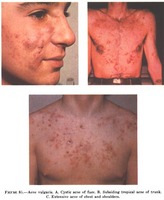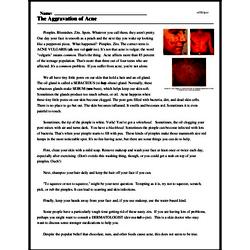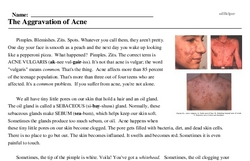The Aggravation of Acne
Pimples. Blemishes. Zits. Spots. Whatever you call them, they aren't pretty. One day your face is smooth as a peach and the next day you wake up looking like a pepperoni pizza. What happened? Pimples. Zits. The correct term is ACNE VULGARIS (ak-nee vul-gair-iss). It's not that acne is vulgar; the word "vulgaris" means common. That's the thing. Acne affects more than 85 percent of the teenage population. That's more than three out of four teens who are affected. It's a common problem. If you suffer from acne, you're not alone.
We all have tiny little pores on our skin that hold a hair and an oil gland. The oil gland is called a SEBACEOUS (si-bay-shuss) gland. Normally, these sebaceous glands make SEBUM (sea-bum), which helps keep our skin soft. Sometimes the glands produce too much sebum, or oil. Acne happens when these tiny little pores on our skin become clogged. The pore gets filled with bacteria, dirt, and dead skin cells. There is no place to go but out. The skin becomes inflamed. It swells and becomes red. Sometimes it is even painful to touch.
Sometimes, the tip of the pimple is white. Voila! You've got a whitehead. Sometimes, the oil clogging your pore mixes with air and turns dark. You have a blackhead. Sometimes the pimple can become infected with lots of bacteria. That's when your pimple starts to fill with pus. These kinds of pimples make those mammoth size red lumps in the most noticeable spot. It's no fun having acne, but there are some things you can do to help.
First, clean your skin with a mild soap. Remove makeup and wash your face at least once or twice each day, especially after exercising. (Don't overdo this washing thing, though, or you could get a rash on top of your pimples. Ouch!)
Next, shampoo your hair daily and keep the hair off your face if you can.




